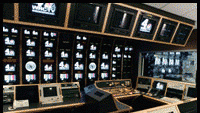Production switchers

When the production staff in a station is asked what they are most interested in, it is likely to be audio consoles and production switchers, for these two tools largely define their ability to excel in their jobs.
The WRC production control room in Washington, DC, is built around a Grass Valley 4000 switcher, which allows up to 64 inputs for video and/or keying. Photo by Felix A. Peña, director of mechanical and computer services for CEI.
Production switchers have changed dramatically in the last 30 years, but strangely (or not so strangely, perhaps) much of the functionality is quite similar. The techniques for achieving functionality are quite different, however. Today, digital switchers predominate in our business. This article will refer to digital switchers without excluding the small number of analog production switchers still in the product lines of manufacturers.
The most obvious parameter to quantify is the number of inputs — the size of the panel. Switchers today are available with from eight to 80 inputs. Small switchers, often with integral digital effects and surprisingly large feature sets, can be purchased for modest amounts of money. A small ENG/EFP production truck might be equipped with such a switcher. They offer memory systems, canned effects, excellent keying, and even remote control by editors and other external devices via GPI/O contact closures and RS-422 control circuits. These small switchers can support two channels of digital effects, and often offer both analog and digital interfaces. They usually offer a single mix-effects system, though 1.5M/E switchers in this range are common.
In larger systems, clearly the number of inputs is likely to grow beyond 16, most often in blocks of 16 inputs. On many systems today the output choices are configurable, due to an internal structure that effectively utilizes an internal routing switcher. This allows any output connection to be configured with any output signal, thus allowing multiple outputs of any format needed without requiring an external distribution amplifier. This can be quite an effective technique for creating a system.
Other new features are also important. Some manufacturers offer aspect ratio conversion on all signals. This permits simultaneous production in both 4:3 (1.33:1) and 16:9 (1.78:1), assuming the internal structure allows an M/E to be effectively split into two separate paths, one in each aspect ratio. This setup provides important protection for future upgrade paths — for simultaneous production and an orderly switchover to widescreen production.
One of the most important things to remember today is that a production that might have required three M/Es in an analog switcher could very well be produced in a 2M/E digital switcher. Digital switchers generally have more keyers, and offer an “anything into anything” re-entry approach. This allows you to reconfigure the flow of a production easily, without being tied to a top-to-bottom flow in the architecture.
Get the TV Tech Newsletter
The professional video industry's #1 source for news, trends and product and tech information. Sign up below.
Finally, this year we have seen the introduction of fully featured digital production switchers that can support either high definition or standard definition on a switchable basis. As with aspect ratio issues, it is clearly valuable to many stations and production studios to have hardware that can adapt to a 525 shoot today and a 1080 shoot tomorrow. (Or 720p, and don't forget frame rates!) This allows a major capital investment without the fear of obsolescence. But what about simultaneous HD and SD production? Today that is possible in two ways. One is easy to envision. Simply use one panel to control two frames of electronics, one in HD and one in SD. If the production is well planned and the sources (all the sources) exist in both formats, this may yield superior native production in both formats.
A second approach is to do two versions of the production in HD, with graphics framed and composed for both aspect ratios and mixed in a single switcher using a second path through each M/E. This essentially requires that each M/E operate as two M/Es and output two distinctly different outputs — a 4:3 copy to be center cut for release and downconversion to SD, and a 16:9 version to be used in native form for the HDTV broadcast. In this case the SD broadcast is produced from the HD sources, and all of the HD broadcast is downconverted in a single operation. A benefit of this method is that SD pictures created from what might be viewed as oversampled images produce superior SD content with no practical compromises. If downconversion were not a well-known and high-quality process this might be problematical. However, the operational simplicity of having one set of electronics and one set of inputs involved in the broadcast is well worth looking into carefully. Several HD mobile units capable of operating in each of these two basic approaches are now on the road, and have been used for high-profile broadcasts quite successfully.
John Luff is senior vice president of business development for AZCAR. To reach him, visitwww.azcar.com.
Send questions and comments to:john_luff@primediabusiness.com
